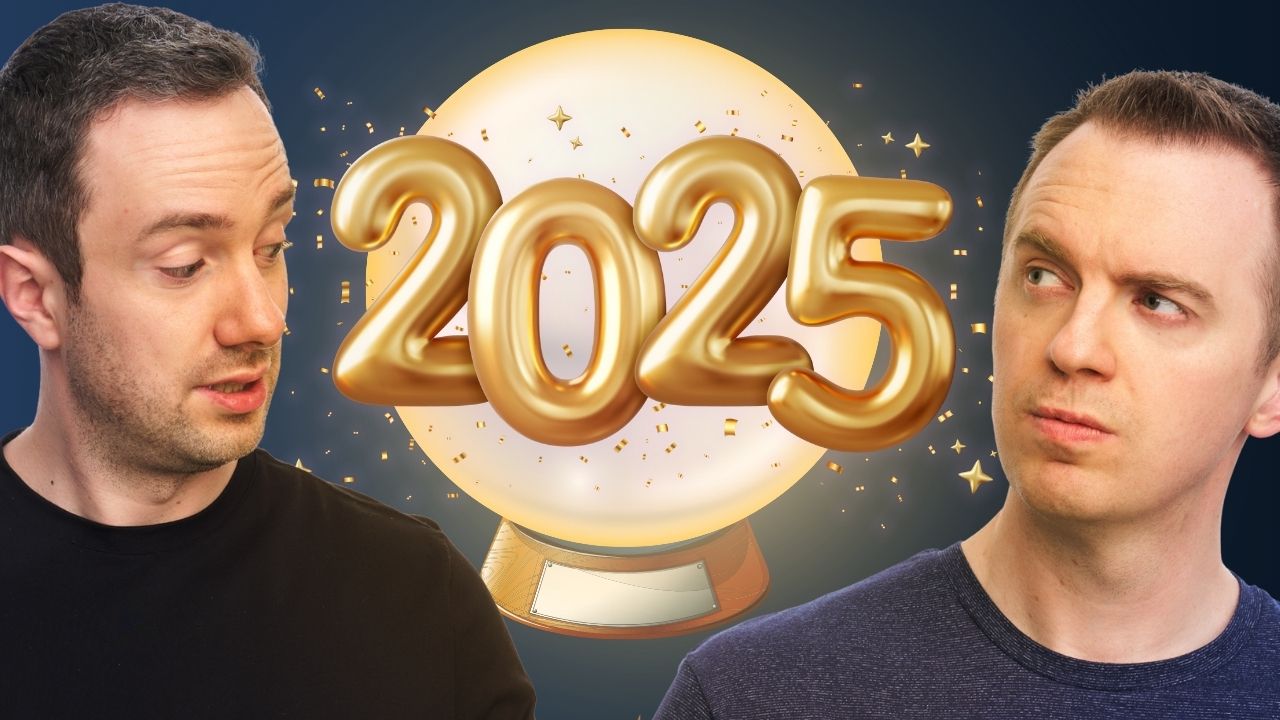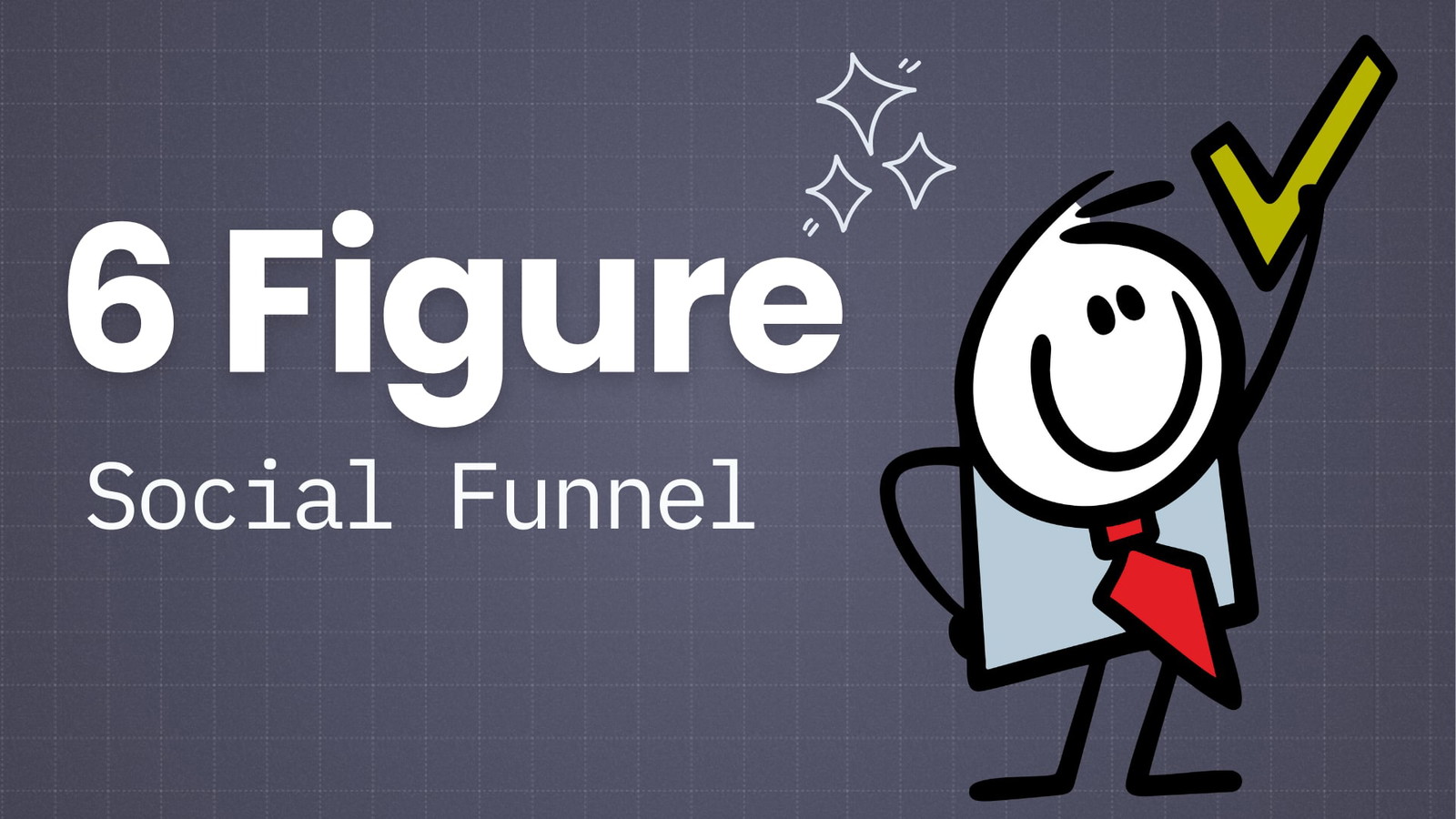Starting a gaming blog is an exciting opportunity.
Not only do you get to play video games and write about your experience, but you can also develop a loyal following – and even make some money while you’re at it.
At Authority Hacker, we’ve helped over 15,000 students – many of whom run gaming blogs – achieve financial success. And we’ve proven it ourselves in building multiple 6-figure affiliate websites.


This 10-step blueprint contains everything you need to know to build your own successful gaming blog.
Why Start a Gaming Blog
Whether you’re a seasoned gamer or just getting started, there are a few compelling reasons you might want to start your own gaming blog.
For starters, gaming is fun, and writing about your passion allows you to experience new games and expand your gaming repertoire. You’ll also get to build a community and connect with other gamers.
And, of course, starting a gaming blog allows you to earn money through channels like affiliate marketing, display ads, and even developing and selling your own products.
In fact, the average entertainment website makes $4,416 per month, according to our affiliate marketing statistics.
What could be better than making money doing something you love?
Examples of Successful Gaming Blogs
If you want to build a profitable gaming blog, it helps to study what successful gaming bloggers are doing.
Here are a few gaming blogs that have built strong followings and generated substantial revenue by creating unique gaming content. Take a look at each and find elements you can emulate on your blog.

Rock Paper Shotgun
Rock Paper Shotgun focuses on PC games and PC gaming equipment.

Gematsu
Gematsu has a tight focus on Japanese games across all systems. They also provide detailed analyses of the gaming news that affects the Japanese sectors, including new releases, awards, and corporate moves.

RetroDodo
RetroDodo is all about retro gaming and nostalgic gaming equipment. They cover classic games and vintage consoles, and dig deep into the early eras of gaming.
How To Start a Gaming Blog in 10 Steps
Ready to launch your video gaming blog? Here’s a step-by-step guide to get started.
1 Narrow Down Your Gaming Niche
Writing about any gaming topic under the sun might sound like a lot of fun, but your gaming blog must have a defined focus.
Gaming is a broad niche, with topics ranging across many systems, genres, and eras. It’s also extremely competitive because gamers are passionate about their hobby, and many will write about it for free. That makes it tougher for you to make money from your blog.
But you can still create a profitable gaming blog with a smart approach.
To build a successful gaming blog, you should choose an area to focus on. This will make it easier to grow an audience – you’ll stand out from the competition, and gamers interested in your sub-niche are more likely to follow your blog.
For example, people looking for information about vintage PC games would prefer a blog specializing in older titles. A general gaming blog that covers a wide range of topics is less likely to appeal to them.
So, how do you pick a gaming blog niche?
Start by considering the aspects of gaming you’re most passionate about. The more you enjoy and know about a topic, the easier it will be to build a blog about it.
Here are some potential gaming sub-niches for inspiration:
- Retro PC Games: Reviews of old-time games and guides on where to find them.
- Retro Systems: Atari, Coleco, Intellivision, etc.
- Specific Games: Minecraft, Fortnite, Red Dead Redemption, Fortnite, etc.
- Specific Systems: PlayStation, Switch, Xbox, Nintendo, etc.
- Type of Game: strategy, FPS, MMO, etc.
- Gaming Gear: chairs, desks, hard drives, controllers, etc.
- Gaming News: Focus on upcoming releases, corporate news, gaming conventions, and more.
- Esports: Cover Esports news, team and player standings, game releases, etc.
- Game Development: Teach people how to develop games or pursue a career as a developer.
Having a passion for your video gaming sub-niche is important because it will keep you motivated to produce great content over the long haul. But you must also ensure your sub-niche is popular enough to build a following and make money.
The best way to do that is to choose a sub-niche that already has successful blogs in it.
Here’s how you can identify gaming topics with a track record of blogging success:
Make a list of existing blogs in each gaming sub-niche you’re interested in. You can find these with a blog aggregator like AllTop, searching Google for keywords you might write about, or plugging a website into the “Organic Competitors” tool on Ahrefs to find similar websites.

Check the traffic levels. You can tell if a gaming blog is successful by checking for high traffic levels. Once you have a list of blogs you like, sign up for a free trial at SE Ranking and analyze the traffic of each in the Competitive Research section.

Compare prospective sub-niches with Google Trends. If you’re having trouble deciding between multiple niches, use Google Trends to compare them to see which gets more traffic.

Once you’ve collected your data, think about your sub-niche for a day or so. But don’t get weighed down by the decision – it’s better to choose something and move forward than get caught up in analysis paralysis.
See our comprehensive YouTube video for more details about selecting a niche:
2 Choose a Blogging Platform
Now that you’ve chosen a sub-niche, it’s time to pick a platform for your blog.
A blogging platform is a software or service that allows users to publish, edit, and manage content on the web.
There are many free options, including social blogging platforms like Medium and Blogger.
However, these free platforms have serious drawbacks:
- It’s hard to make money from them.
- They usually limit what types of content you can post.
- You can’t customize the design and functionality.
Building your website is the smartest option if you want full control over your blog and sky-high earnings potential.
It gives you serious advantages that no other blogging platform offers:
- Compared to other platforms, it’s easy to make money with affiliate products and display ads.
- No one can shut down your website or delete your content.
- You can post whatever type of content you want.
- You have full control over the look and feel of your blog. It’s your blog, and you should have total authority over its design.
- You can use search engine optimization (SEO) to target relevant keywords and drive traffic to your blog.
- You can grow social media accounts and drive traffic to your website.
- You can build an email list to diversify traffic and provide another avenue for product promotion.
- You’re building an asset that you can sell. ( We’ve built and sold multiple blogs for 6-figure sums.) That wouldn’t have been possible if we’d built them on other platforms.
The best platform for building your own website is WordPress – specifically the self-hosted WordPress.org (not WordPress.com).

It’s free, easy to use, and has thousands of plugins and themes that let you tailor your site to fit your exact needs.
WordPress is the best choice for most bloggers, but it’s not the only option. If you’d like to view the alternatives to WordPress, check out our list of the best blogging platforms.
3 Choose Your Domain Name
The next step in building your new video game blog is to choose your domain name.
A domain name is a unique web address for your site. It includes the name of the site and the domain extension (like .com). It’s part of the URL people will use to access your site.

Choosing a good domain name is important because it will be the foundation of your brand.
Here are a few tips to keep in mind when choosing your domain name:
- Choose a .com domain extension. These carry a level of trust and familiarity that other extensions lack. See our list of .com alternatives if you’ve found a truly awesome name that doesn’t have the .com version available.
- Match it to your niche. Align your domain name with the sub-niche you chose. For example, pcgamecave.com might work well for a PC gaming blog.
- Keep it broad. Don’t make the domain name so specific that you can’t expand into other sub-niches down the road. You may want to start out blogging about a few PC titles, for example, but it could make sense to expand into PC game peripheral reviews later on.
- Keep it short. Short domain names are easier to remember – 3 words should be your maximum length target.
- Make sure it’s not trademarked. Run your domain name ideas through the USPTO site to see if someone else owns the name.
If you’re struggling to find a good domain name, AI domain generators like Brandsnap can help you find a creative name that’s still available.
Once you’ve chosen a domain, you must buy it from a domain registrar. You can easily get one on Namecheap for around $10.
4 Buy Web Hosting
Once you have a domain, you’ll need to choose a web hosting provider.
A web host is a service that offers the necessary infrastructure to store, manage, and serve your WordPress website to users on the internet.
Bluehost is a popular option; many sites start with it because it’s inexpensive. However, we recommend SiteGround. It’s a better alternative, providing superior speed, reliability, and support for a slightly higher price.
Here’s a quick step-by-step guide on getting set up with SiteGround hosting:
Step 1: Go to SiteGround’s WordPress hosting page.
Step 2: Choose the StartUp plan. It’s the cheapest and has all the essentials – perfect for a new blog. Note that the price increases after the first year.
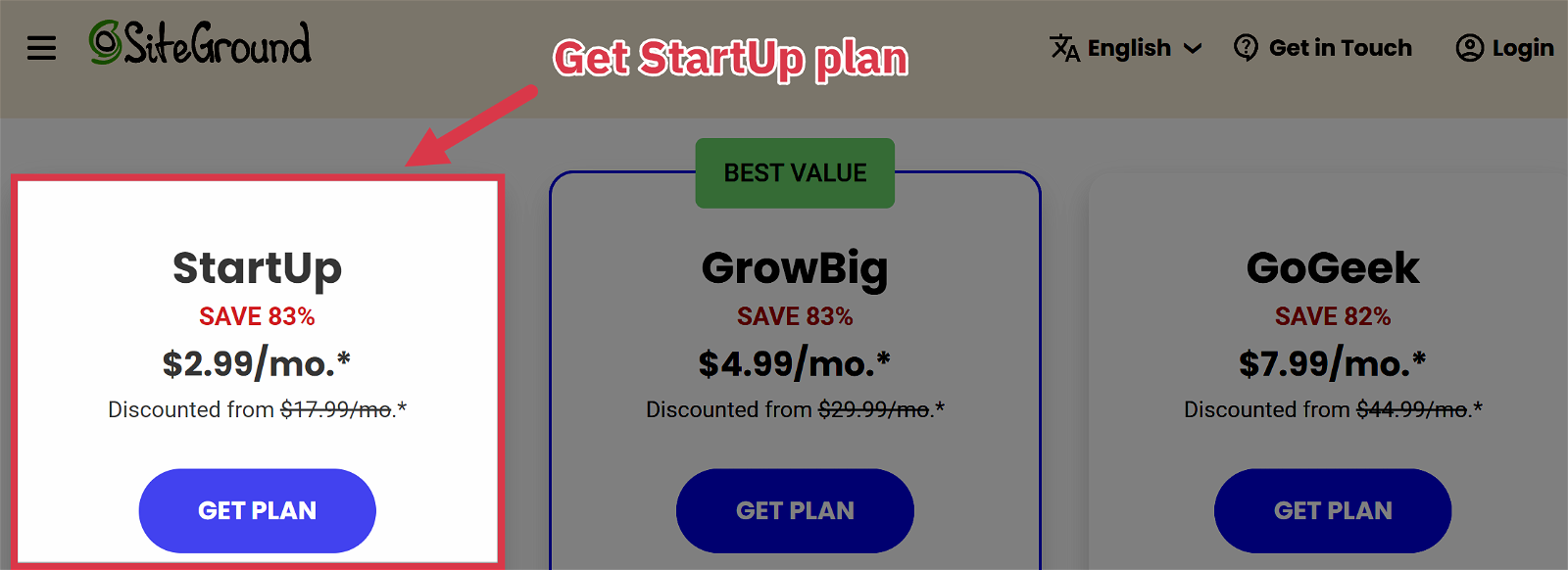
Step 3: Select “I already have a Domain” and enter your domain. (Unless you didn’t get one from Namecheap):

Step 4: Fill in your account and location details:

Step 5: Enter payment info and choose the subscription duration. The 12-month option usually offers the best deal.

Step 6: Skip the extra services for now. You won’t need any for a new blog.
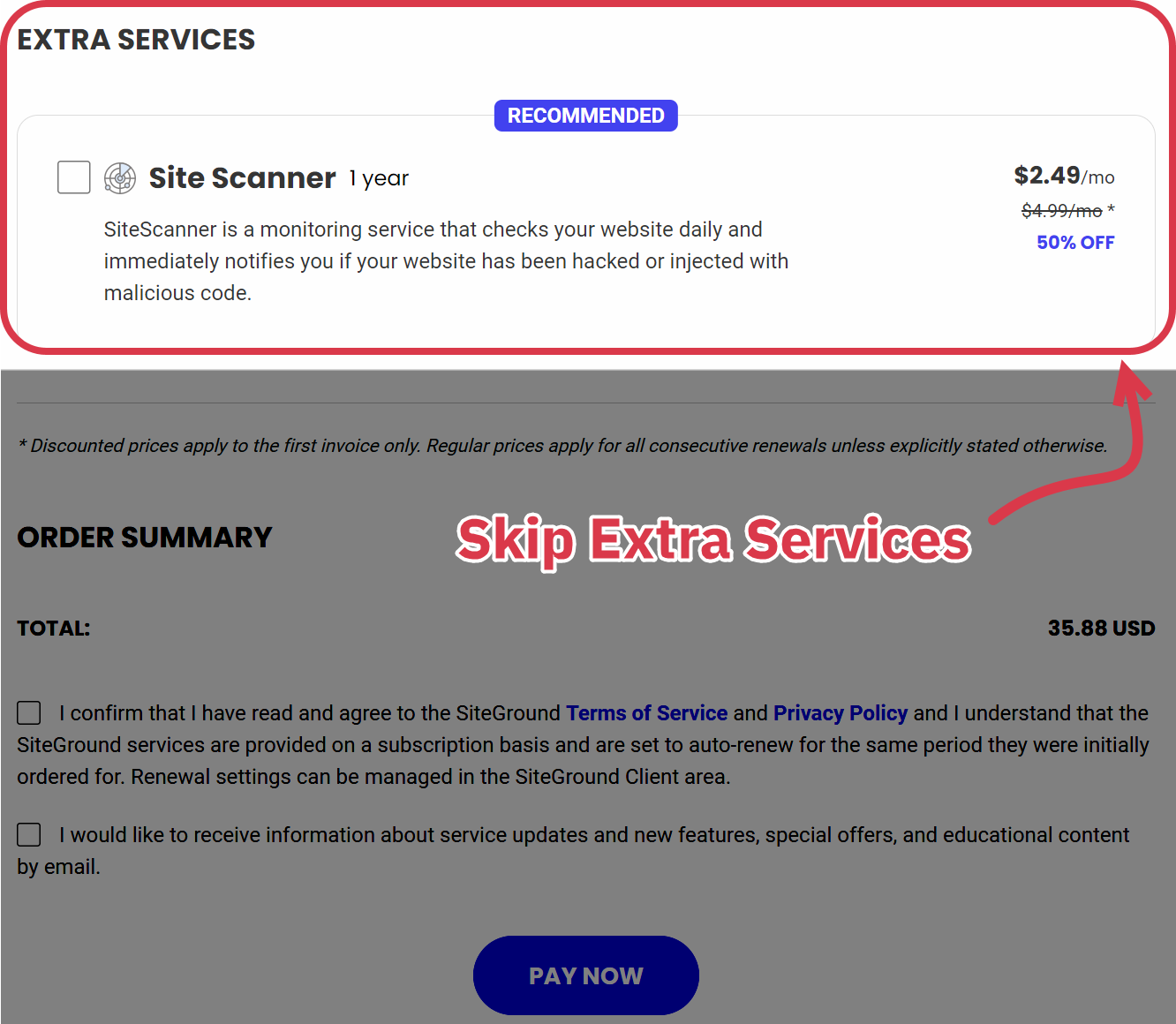
Step 7: Point your domain to SiteGround. If you got your domain from Namecheap (or any other registrar), you’ll need to change the DNS settings to SiteGround. Contact SiteGround support if you need help with this.
And that’s it! You now have hosting for your new gaming blog.
5 Choose a Theme for Your Gaming Blog
Now that you have a hosting account, it’s time to set up your WordPress blog and choose a theme.
A WordPress theme is the visual framework that gives your blog structure and design. It should complement your niche choice and brand. For example, if you’re starting a vintage PC game blog, you might want a theme with a retro look and feel.
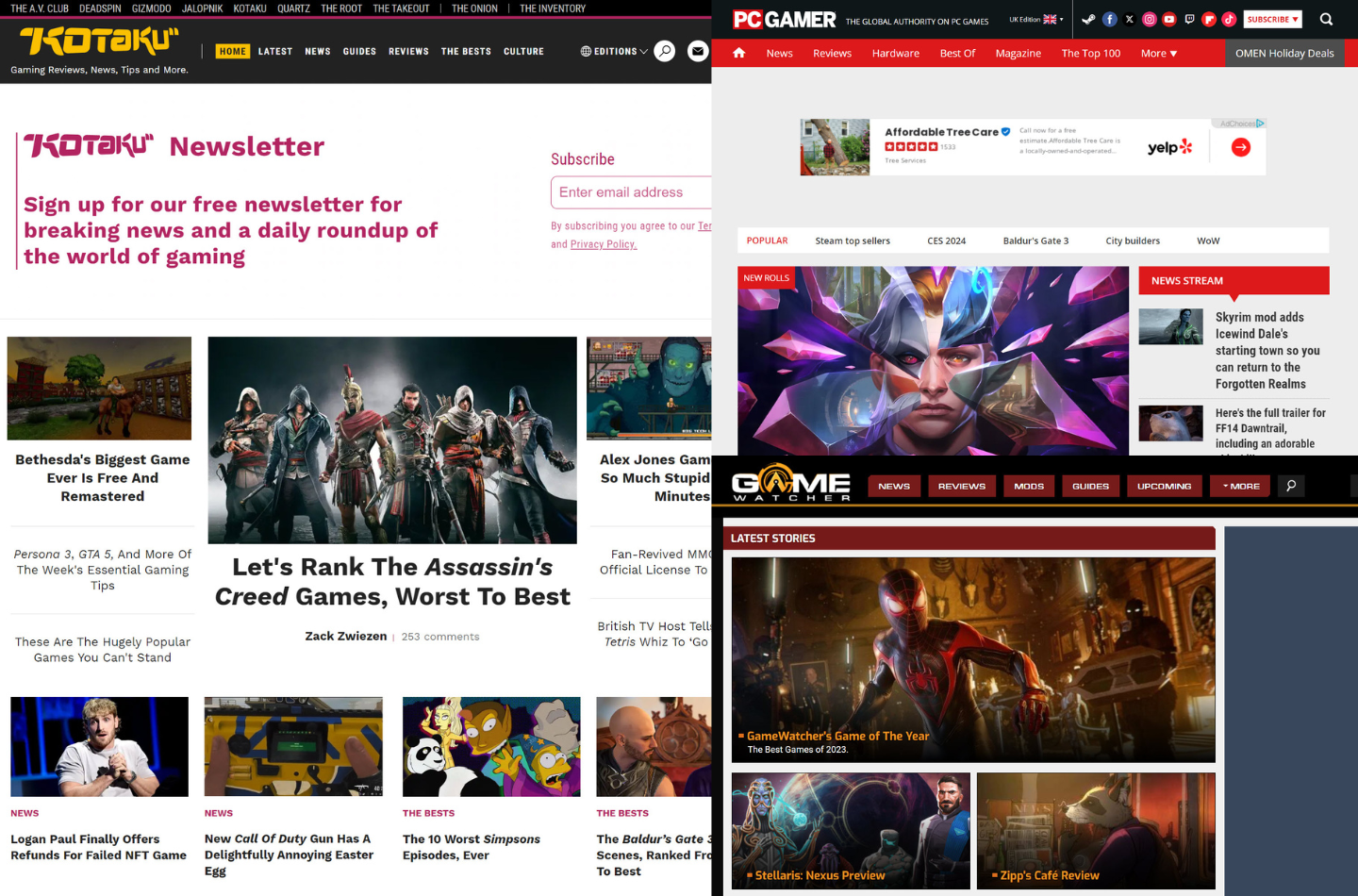
When choosing a theme, you’ll have to decide whether or not you want to pay for one.
It’s okay to begin with a free theme, but you should choose one that has a premium upgrade option. Free themes work well enough while you’re just starting, but you’ll quickly find they have limitations that will prevent your gaming blog from reaching its full potential.
Some good choices for your first theme are Astra, Kadence, and GeneratePress.
Each of these themes has extensive template libraries that let you quickly select a pre-built design. They also have free versions that give you a feel for them before purchasing.
Once you have a theme, you need to install it on your WordPress site. Here are the step-by-step instructions:
Step 1: Go to your WordPress dashboard.
Step 2: Go to the left sidebar and select Appearance > Themes
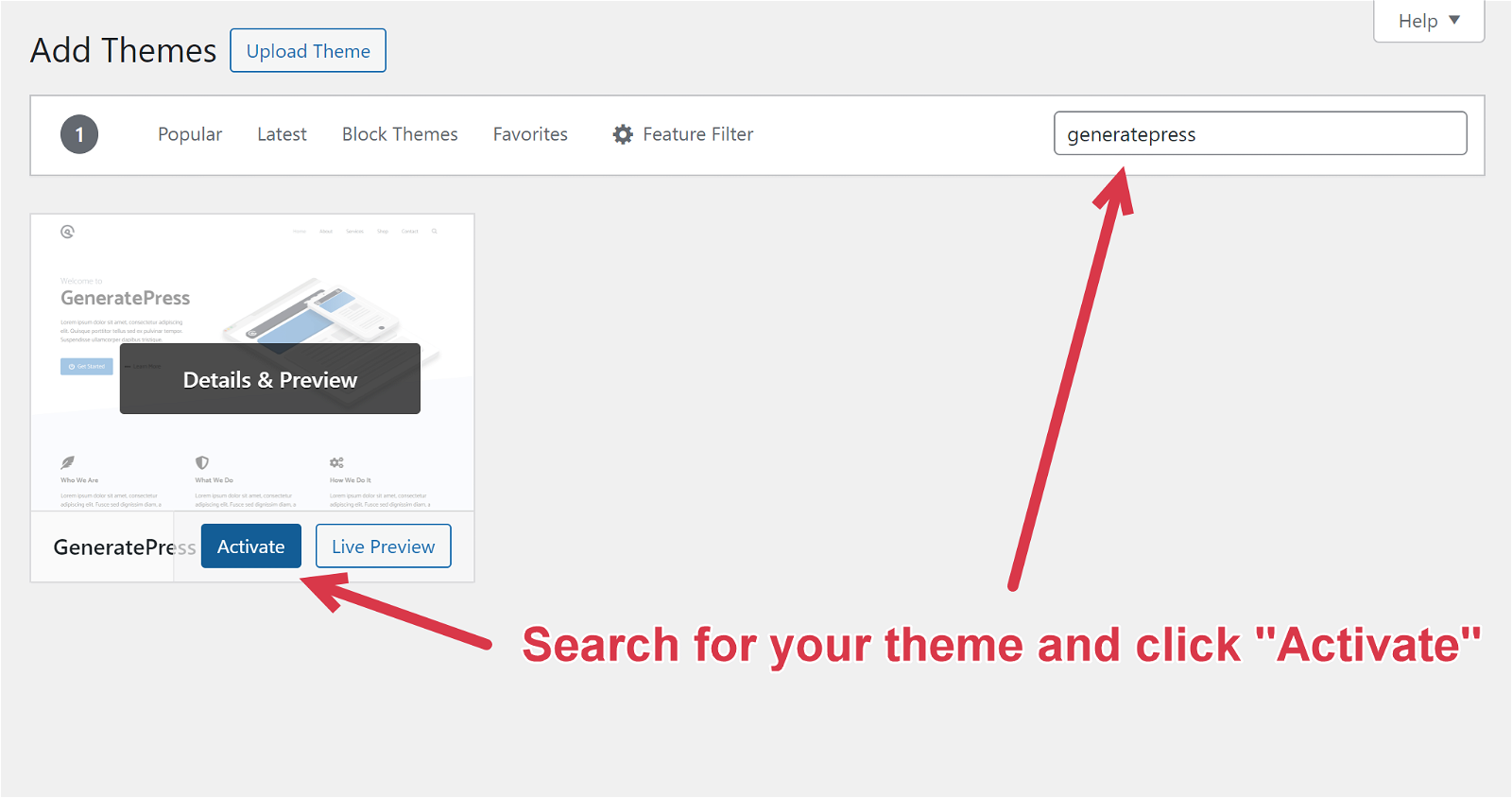
Step 3: Click “Add New.”
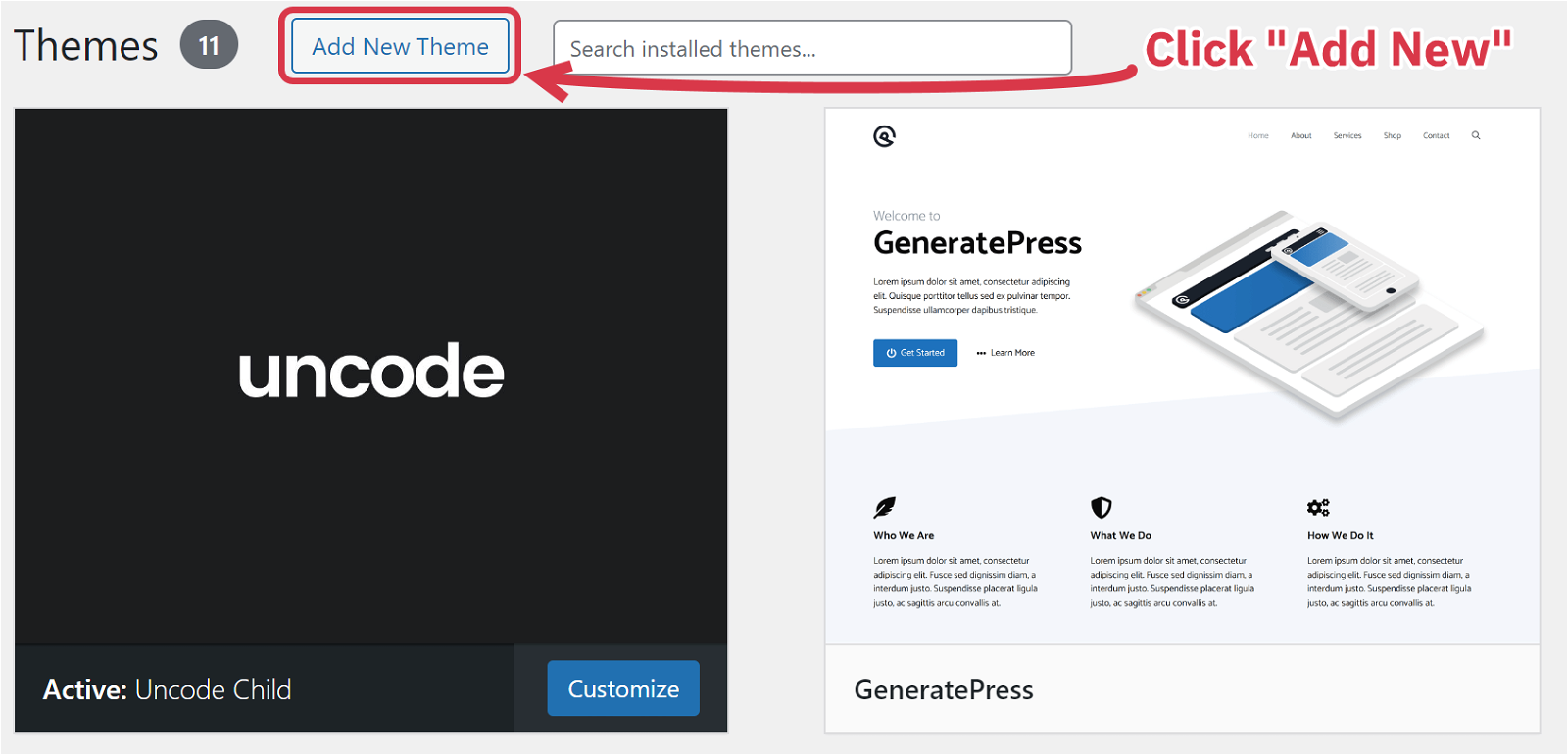
Step 4: Search for your theme and click “Activate.”

And you’re done! You can now start customizing your theme and adding personal touches to the website.
6 Decide on Design & Branding
Your WordPress theme provides a basic framework, but now it’s time to fine-tune your site aesthetic to match your brand and blog niche.
This is a crucial step in making your site the best it can be.
Your design choices will become an extension of how visitors perceive your gaming blog. Pick a set of colors and a logo that mesh well and communicate the vibe of your site. For example, a retro gaming blog could use neon magenta for vibrant accents, green for backgrounds or large elements, and black for text and contrast.
To get started, you need to define a color palette to match the tone of your brand and niche. Spend time here to get it right because color affects all your future design decisions.
The good news is you don’t have to be a design expert to choose a cohesive palette. You can use Coolors to easily create a harmonious color scheme.

Once you pick your colors, it’s time to create your site’s logo.
Your logo sets the tone for your whole site and is often the first thing visitors see. As such, it should match your brand and niche, just like your colors do. For example, many gaming logos have black backgrounds and white or neon images and text.
If you’ve never designed a logo before, don’t worry. You can use Canva to find a logo template that matches your website’s aesthetic. Then, once you find a good template, customize it to fit your brand colors and gaming blog name.
Here’s a look at some Canva templates for gaming logos:

7 Create Essential Pages
Now it’s time to add some essential pages that every blog needs. Don’t leave any of them out!
Homepage
This is the “home base” of your website. It should signal what your site is about and make it easy for visitors to find what they’re looking for.
About Page
This is where you share your background with gaming and show your audience who you are. Explain why you started your gaming blog and your vision for what you want to achieve with it. Add personal stories, discuss your favorite games, and include a picture or two to make this page relatable and inviting.
Contact Page
At a minimum, this page should include a contact form, email address, and links to any gaming-related social media channels you have.
Privacy Policy + Terms & Conditions Pages
These are necessary legal pages that explain what information you collect from users and dictate how visitors can use your site. You can easily generate both at PrivacyPolicies.com.
Creating a new page is easy. Just log in to your WordPress dashboard, click the “Pages” menu, and then “Add New.”
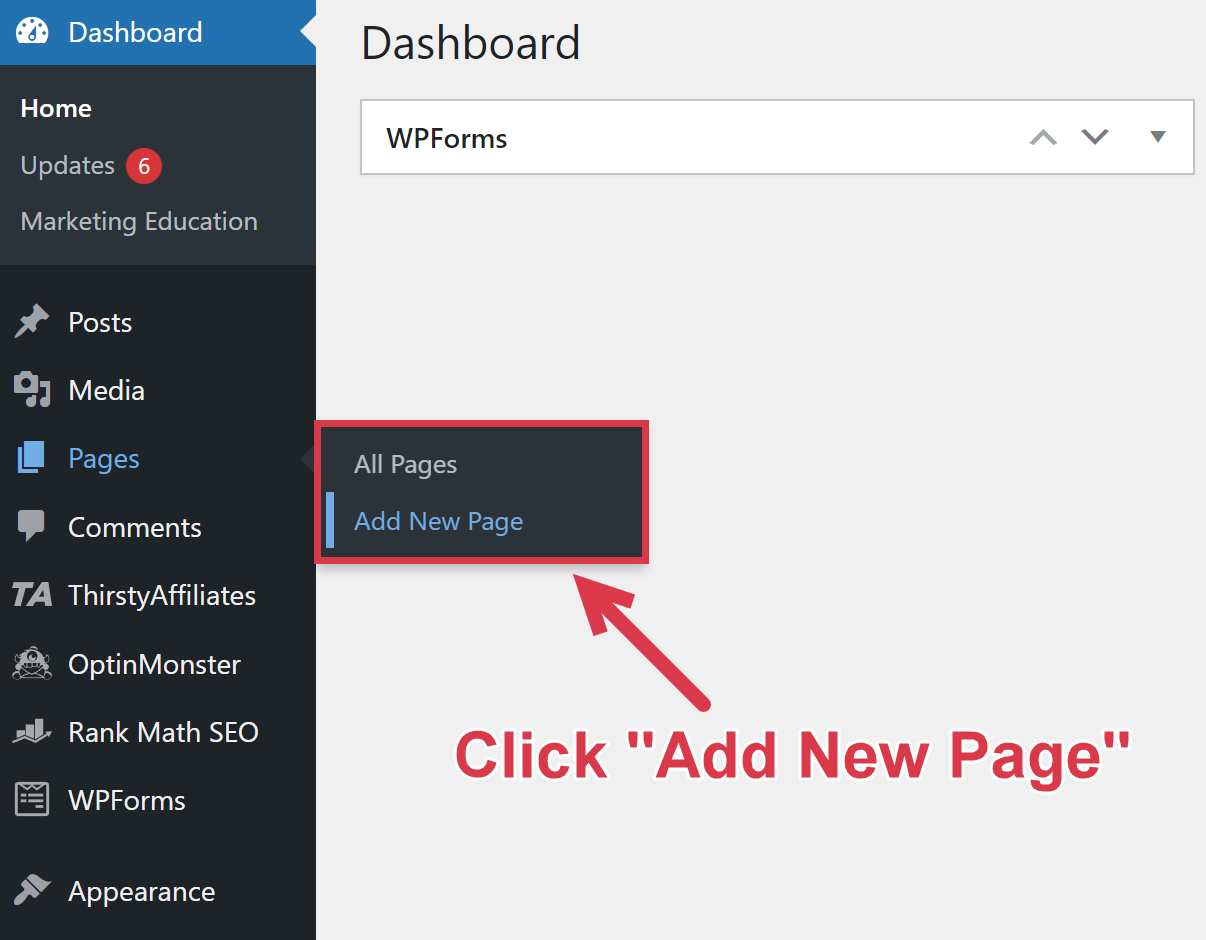
8 Start Creating Content
This is the payoff for all the work that went into setting up your gaming blog. You finally get to create your first blog post!
When you’re coming up with blog post ideas, remember that you want to create keyword-focused content to ensure people find and read your gaming blog.
A keyword-focused strategy means you pick phrases people are searching for and write content that answers their questions.
If the search engines like your content, they’ll show it on the results page when people search for your target keyword. That’ll help you get traffic to your website and ultimately earn money.
But you can’t just write about any old gaming topic and expect good results. Instead, you need to balance low competition with decent monthly volume when you’re picking your keywords.
Ahrefs is the best tool for finding these low-competition keywords with high search volume.
You can type a “seed keyword” into the Ahrefs Keyword Explorer to find relevant related terms and their estimated search volumes.
For example, if you type “old PC games” into Ahrefs, you get the following matching terms:
| Keyword | Search Volume | Keyword Difficulty |
|---|---|---|
| old pc games 2000 to 2010 | 450 | 9 |
| old pc games 90s | 300 | 10 |
| old pc games 2000 | 500 | 7 |
| low end pc games | 350 | 23 |
| old pc hunting games | 90 | 2 |
Use this keyword research strategy to plan out your first 10 blog posts. Here are some great gaming blog post ideas from the keyword results above:
- “25 Best Old PC Games to Play This Weekend”
- “Top 10 Websites to Play Old PC Games Online”
- “5 Best Old Shooting Games for PC”
Now, armed with some great titles based on your keyword research, it’s time to start writing.
Here are some tips that will help you craft amazing SEO-optimized blog posts for your gaming blog:
- Understand search intent. Make sure you know what your audience really wants when they search for your target term. Outline the key points you need to hit to meet their needs before you write your first draft.
- Consider your audience. Consider who will be reading your post and use the language and terminology that would resonate with them. Gamers generally don’t want to read a formal paper, so keep it casual, use game jargon where it makes sense, and be as relatable as possible.
- Share personal stories. Show that you know what you’re talking about and have experience with the gaming topic you’re writing about. A personal story can add life to your post and help you stand out from the competition.
- Link to other posts on your blog. Send readers to other relevant posts you’ve written, focusing on helping them further their gaming enjoyment and understanding. Linking to other posts on your blog also helps with SEO!
- Write with emotion. No one wants to read robotic text. So write like a human, and one who is enthusiastic about gaming!
- Use images and other visuals. Good images and graphics help convey your point and keep the reader engaged by breaking up the text. Screenshots can be especially powerful for making a gaming blog come to life.
- Cover releases and conventions. The gaming community loves to talk about new releases and gaming conventions, so there are plenty of topics you can tackle to cover these news events.
- Provide hands-on advice. Gamers are always looking for ways to make their gaming experience more enjoyable. Use your experience to give tips on playing and winning at various games, setting up game systems for maximum enjoyment, or providing game walkthroughs.
The quality of your content will make or break your blog, so make sure to put in the time and effort to make it great. Engaging, search-focused posts will get your blog moving forward like nothing else.
9 Promote Your Gaming Blog
As important as creating quality content is to your blog’s success, it’s just the first step.
You need a smart promotion strategy to make sure your post gets in front of as many readers as possible as quickly as possible.
Here are the best promotional strategies for increasing the reach of your gaming blog:
- Share posts in gaming communities: Gaming forums can be great places to share your expertise and blog posts as long as you add value. Social media is also a great way to tap into the gamer community. There are several popular Facebook groups dedicated to retro gaming, for example. And Discord communities are huge with gamers.
- Build an email list: Ask visitors to sign up for your email list in exchange for a gaming-focused freebie, like a cheat sheet for a particular game. Then, email new content and affiliate offers to your list.
- Collaborate with other gamers and gaming bloggers: Consider partnering with other gamers or game bloggers to promote each other’s content. This approach works well with complementary sub-niches. For example, a PC gaming blog could hook up with a PC equipment review site. You could also partner with Twitch streamers to tap into their dedicated gaming audiences.
- Start a Twitch channel: If you play games all the time, starting a Twitch channel gives you the chance to stream your session and connect with other gamers. You can promote your blog to that new audience. You could also do the same thing with a YouTube channel.
- Start a local game night: Organize a night for local gamers to get together, talk shop, and play games. You can sponsor the event by providing snacks and serving as an MC. Make sure to mention your blog and ask the group to check it out. You could even ask for feedback and content ideas.
- Advertise yourself at conventions: If you’re attending a gaming convention, wear a t-shirt with your blog logo and URL. Or print up some business cards to leave with other gamers or vendors you talk to. Conventions are full of gamers looking for information, and your blog just might be what they need.
However you promote your blog, make sure it’s genuine and helpful. No one will follow you if you simply spam links to your website everywhere.
10 Monetize Your Gaming Blog
You’ve put in a lot of work to this point, so it’s time to make some money from your blog!
Here are three ways you can monetize your gaming blog without destroying your readers’ experience:
Affiliate Marketing
Affiliate marketing lets you Recommend games, equipment, guides, or books you love. Include links to third-party sellers to earn a commission for each purchase.
Why It’s Great: Help your audience get more out of gaming while earning money. Plus, you can start earning immediately, even with low traffic.
Get Started: Check out our guide on how to start affiliate marketing and our list of the best gaming affiliate programs.
Display Ads
You can show ads to your audience through ad networks or direct sponsorships.
Why It’s Great: You get paid when your audience interacts with an ad, providing a revenue stream that aligns with your content.
Get Started: Choose an ad network like Ezoic, which we recommend over Google Adsense. Switch to a higher-paying network like Mediavine or Raptive when you have more traffic. Joining an ad network is the easiest route, but direct sponsorships offer more control and potential profit.
Sell Your Own Products
You can also monetize your blog by selling digital products like game guides, tutorials, or even physical creations related to your gaming content.
Why It’s Great: You can leverage your expertise to tailor your offering to your audience and keep all the profits.
Get Started: Identify your audience’s needs and figure out how to solve their problems. For example, gamers might want game walkthroughs or video tutorials on building a gaming system. Platforms like Etsy for physical goods or Teachable for courses can be excellent starting points.
Sponsored Content
Partner with gaming companies to create content promoting their products.
Why It’s Great: You can recommend products you love and get paid upfront to do so.
Get Started: Make a “Work With Us” page that shares audience information, including general demographics, monthly blog visitors, and social media follower counts. Mention the types of content that you can produce, along with any rules companies must be aware of if they want to work with you. This page from SitePoint is a solid example.
See our guide to monetizing a blog for more tactics.
Summing Up
I gave you the most important steps for building a gaming blog as best as I could.
But while this guide gives you the fundamentals, I can’t hope to share everything you’ll need to know to maximize your chances of success in this single post.
That’s why we’ve developed a free training that dives even deeper into the strategies that can accelerate your blog’s growth.
In this training, you’ll get 7 insider tactics that can boost your blog’s success rate by 83%.
We wish we had known these game-changing strategies when we started out. And that’s why we’re sharing them with you.
If you’re committed to turning your gaming blog into a profitable venture, this is the next step.
FAQs
Gaming blogs can make money. The average entertainment website – of which gaming is included – earns $4,416 per month.
By leveraging affiliate marketing, display ads, and selling unique products, you can turn your passion for gaming into a successful blog venture.
You can set up a gaming blog by choosing a niche and domain name, obtaining hosting, installing a blogging platform like WordPress, customizing your website to your liking, and writing blog content.
Your content strategy should involve keyword research if you want to drive steady traffic to your blog from organic search results.






